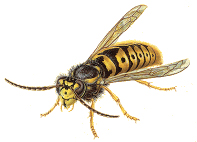Fact Sheet FS212
Hornets, yellow jackets, Polistes, mud daubers, and the cicada killer are all wasps, a group of beneficial insects that attack and destroy other insects found around homes and in gardens.

Wasps, however, can attack people as well as insects. Hornets, yellow jackets, and Polistes may sting if you go near their nests. Mud daubers and cicada killers usually will not sting unless you touch them or if they get caught in your clothes.
If a person with a history of asthma, hayfever, or other allergic reactions is stung by a wasp, a physician should be notified immediately.
If wasps build their nests too close to your house or in bushes where children play, you should destroy the nests.
Nests
Wasps can be identified by the nests they build and where they build them.
Hornets, Polistes, and mud daubers build their nests above ground. Hornets and Polistes nest in trees, shrubbery, and under eaves. Mud daubers nest under eaves, porch roofs, and behind shutters; they do not nest in trees or shrubbery.
Yellow jackets usually construct their nests in the ground but sometimes will build above ground. Cicada killers nest in the ground.
Hornets and yellow jackets build football-shaped, paper-like nests. Polistes build paper-like nests that resemble a honeycomb. Mud daubers build clay or mud-cell nests. Cicada killers dig holes (about ½-inch across) in sloping ground and pile the excavated soil beneath the opening.
Hornets, yellow jackets, and Polistes abandon their nests in the fall. The old nests are not reused and usually disintegrate or are torn apart by birds or squirrels. These insects are perpetuated by the hibernating queens. Mud daubers and cicada killers overwinter as resting larvae in their nests.
Control With Insecticides
Wasps can be controlled by applying an insecticide to their nest. Treat nests at night when there is less danger of being stung.
The kind of insecticide needed to kill wasps depends upon whether the nest is above ground or in the ground. In either case, be sure the insecticide is labeled for hornets, wasps, or yellow jackets.
Nests Above the Ground
Apply the insecticide as a spray using a commercially prepared, pressurized spray or use a conventional pump-type, compressed air sprayer. Be sure to mix the proper insecticide concentration in the spray tank according to label directions.
The most convenient method of control is a commercially prepared, pressurized spray for wasps that will propel the insecticide 8 to 10 feet or more. Be careful—always point the sprayer opening away from you. Never look into the sprayer opening if it appears clogged or otherwise malfunctions. Keep children and pets away from the area being treated. Read and follow carefully all directions on the label.
Insecticides most commonly available in commercially prepared, pressurized spray are: resmethrin, permethrin, tetramethrin, cyfluthrin, propoxur, DDVP, and pyrethrins; as well as WASP-FREEZE type materials.
Insecticides labeled for wasp control and applied using a conventional pump-type, compressed air sprayer are: carbaryl, bendiocarb, and propoxur. Follow the label directions and mix the appropriate amount of insecticide and water. Turn nozzle to deliver a coarse spray and apply to the nest.
Nests in the Ground
Try to locate the nest opening. This is not always easy, especially when ground cover (such as ivy) is present. For the most effective control, the insecticide must be introduced into the nest opening.
Pressurized sprays containing Resmethrin are reasonably effective for ground-nesting situations. Cover the nest opening with a shovelful of moist soil after the treatment.
Examples of Nests
Mention or display of a trademark, proprietary product, or firm in text or figures does not constitute an endorsement by Rutgers Cooperative Extension and does not imply approval to the exclusion of other suitable products or firms.
August 2003
Copyright © 2024 Rutgers, The State University of New Jersey. All rights reserved.
For more information: njaes.rutgers.edu.
Cooperating Agencies: Rutgers, The State University of New Jersey, U.S. Department of Agriculture, and Boards of County Commissioners. Rutgers Cooperative Extension, a unit of the Rutgers New Jersey Agricultural Experiment Station, is an equal opportunity program provider and employer.

